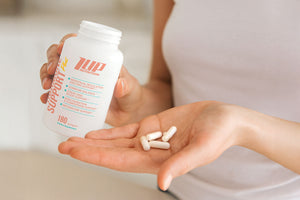Despite rigorous dieting and diligent training, many individuals experience weight gain during the first few weeks of their transformation challenge.
If this happens to you, let us be the first to tell you that this is completely normal.
In other words, don’t panic!
There are several legitimate reasons why the number on the scale might be going up instead of going down during the early days and weeks of your weight loss journey.
Here are five reasons why you may be gaining weight while working out.
5 Reasons You Might Gain Weight When Working Out
High-Calorie Diets
There’s no other way around it -- in order to lose weight and get the weight loss results you seek, you have to be in a calorie deficit.
In other words, you must burn more calories per day than you consume.
Many individuals may think that they are eating at a deficit, but the truth is, the average person vastly underestimates just how many calories they consume each day.
All of those nibbles, bites, and tastes add up at the end of the day and can be the “hidden enemy” stalling you from losing fat and causing you to gain weight.
That’s why we strongly suggest that individuals entering our transformation challenge track everything they eat (and drink!) each day.
Tracking your food and beverage intake is easier than ever, especially with the litany of smartphone macro apps available.
Remember, the only way to know with any reasonable amount of certainty if you are actually in a calorie deficit is to track your nutrition.
The first step towards doing that is to estimate your daily calorie needs, which you can do here.
Once you have an estimate of how many calories it takes to maintain your weight, you can the decide how large of a calorie deficit to utilize. To lose roughly one pound per week, you need to consume a 500 calorie deficit each day of the week.
One easy way to help create a calorie deficit is to reduce the amount of processed foods that you consume throughout the day.
Processed foods are typically high in carbs, fat, salt and calories, while being low in fiber and micronutrients. Processed foods also tend to leave us feeling hungry afterwards.
Shifting the focus to consuming greater amounts of whole foods can help you maintain your calorie deficit without feeling like you’re starving yourself.
Greater Glycogen Stores
For high intensity exercise like resistance training, sprinting, CrossFit, etc., your muscles primarily rely on glucose for energy, which it gets from either the glucose in your blood (aka blood sugar) or glycogen (the storage form of glucose within muscle cells).
We’re all born with a certain amount of glycogen stores, but regular exercise has been shown to increase the amount of glycogen stores an individual has.[1,2] This is one of the many physiological adaptations that occurs as a result of exercise.
So, what does this have to do with your scale weight?
Well, when your body stores glucose as glycogen it also stores around 3 grams of water for every gram of glycogen created. This additional water storage within muscle tissue can lead to a small increase in the number you see on the scale.
But, fear not.
As you become more experienced with training, your muscles become more efficient and will retain less water. So, after just a few short weeks of consistent training, the perceived increase in body weight will be gone!
Building Muscle & Strength
It’s a fact of fitness that muscle weighs more than fat, which means if you’re training hard and eating right, you could be building muscle and gaining strength while at the same time losing fat.
What this means is that while you may have lost body fat (as evidenced by your clothes fitting better), the number on the bathroom scale might be slightly higher.
This is why you shouldn’t solely rely on body weight to determine progress. It is a single marker to track your success with diet and training, but by no means is it the only marker to use.
The bathroom scale can’t track how many inches you’ve lost or how much strength you’ve gained. It just gives a number without any reference for how much of that is muscle, fat, bone, or water.
Therefore, don’t “put all of your eggs” in the basket that is the bathroom scale. It can give you an idea how you’re progressing with your goals, but it is one part of a more comprehensive tracking system (that should also include progress photos and a measuring tape).
Water Retention
Exercise is a (beneficial) stressor to the body that causes muscle breakdown and damage.
In the hours and days following intense exercise, the body institutes a host of repair and recovery mechanisms, which involve necessary amounts of inflammation.
This inflammation (while important for recovery and growth) also leads to slight amounts of water retention, which may cause your body weight to be slightly higher.
As your body fully recovers from training, the inflammation and extra water retention will subside.
Just make sure to drink plenty of water each day to support the body’s needs.
Time
Losing fat, much like building strength, is not a linear process, which means your progress can be uneven from one week to the next.
For instance, you may lose 1 pound one week, but the next, you might not lose any. Then the following week, your scale weight might drop another two pounds.
This uneven progress is something that is to be expected.
But, trust the process.
If you’re following your nutrition plan and training program, and seeing results in the mirror, then you know you are on the right path.
Don’t worry about minor fluctuations in body weight from one day to the next. Look for bigger trends -- how the number on the scale is trending over the course of several weeks or months.
References
- Saitoh, S., Shimomura, Y., Tasaki, Y., & Suzuki, M. (1992). Effect of short-term exercise training on muscle glycogen in resting conditions in rats fed a high fat diet. European Journal of Applied Physiology and Occupational Physiology, 64(1), 62–67.https://doi.org/10.1007/bf00376442
- Manabe Y, Gollisch KS, Holton L, et al. Exercise training-induced adaptations associated with increases in skeletal muscle glycogen content. FEBS J. 2013;280(3):916–926. doi:10.1111/febs.12085






